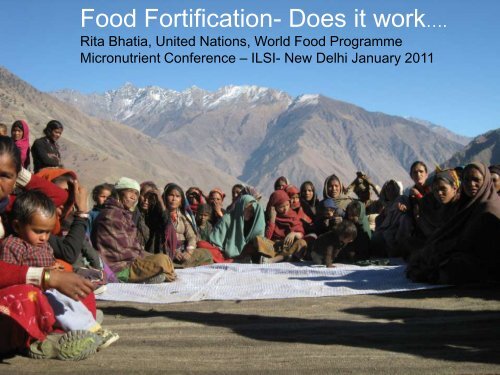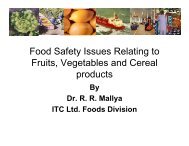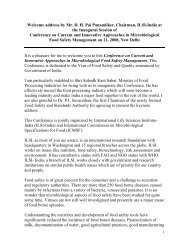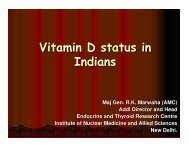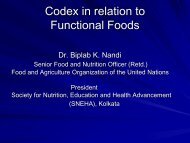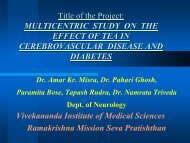World Food Programme Experiences by Dr. Rita Bhatia ... - ILSI India
World Food Programme Experiences by Dr. Rita Bhatia ... - ILSI India
World Food Programme Experiences by Dr. Rita Bhatia ... - ILSI India
You also want an ePaper? Increase the reach of your titles
YUMPU automatically turns print PDFs into web optimized ePapers that Google loves.
<strong>Food</strong> Fortification- Does it work….<br />
<strong>Rita</strong> <strong>Bhatia</strong>, United Nations, <strong>World</strong> <strong>Food</strong> <strong>Programme</strong><br />
Micronutrient Conference – <strong>ILSI</strong>- New Delhi January 2011
How Big is the Problem ???<br />
Over 2 Billion people worldwide suffer from<br />
Micronutrient deficiencies<br />
Undernutrition contributes to one-third of disease<br />
burden death and disability in the developing world<br />
Iron-deficiency anemia affects every second pregnant<br />
woman and over 40% of preschool children<br />
Estimated reduction in GDP <strong>by</strong> 2% in developing<br />
countries<br />
( source: UNICEF and <strong>World</strong> Bank)
v<br />
Pellagra<br />
Goiter<br />
Cretinism<br />
Anemia<br />
Anemia<br />
Beri-Beri
How to Access Nutrients ???
Cases per 1,000 per day<br />
Bhutanese Refugees in Nepal:<br />
MDD Surveillance (Jan ‘94 - Mar ‘96)<br />
3.5<br />
3<br />
2.5<br />
2<br />
1.5<br />
1<br />
0.5<br />
0<br />
Jan<br />
May<br />
Sep<br />
Jan<br />
May<br />
Sep<br />
Jan<br />
Pellagra Scurvy Beriberi<br />
Source: ENN, Issue 5; 1998<br />
<strong>Food</strong> & Nutrition Training Module 5
Bhutanese Refugees in Nepal<br />
6<br />
Blended food removed from ration<br />
<strong>Food</strong> & Nutrition Training Module
Strategies<br />
Diet Diversity and nutrition education:<br />
consumption of local food and education on benefits<br />
of vitamin/minerals -health<br />
<strong>Food</strong> Fortification: addition of vitamin and<br />
minerals to staples, condiments etc<br />
Supplementation: Provision of Vitamin and<br />
Minerals through capsules, tablets and syrup
Copenhagen Consensus 2008<br />
<strong>World</strong>’s top economists convened to prioritize<br />
how international development dollars should<br />
be spent<br />
• <strong>Food</strong> fortification ranked second among all<br />
international development priorities<br />
• <strong>Food</strong> fortification is viewed as highly cost-effective:<br />
benefit.<br />
Source: Horton et al Copenhagen Consensus 2008- Malnutrition and Hunger – Executive<br />
summary
WFP’s areas of intervention<br />
10<br />
1. Local production<br />
2. Feasibility study<br />
3. Factory inspection<br />
4. <strong>Food</strong> fortification process<br />
5. Quality assurance<br />
6. New product development<br />
7. Specification improvement<br />
8. Partnership<br />
New biscuit packaging<br />
Container<br />
specifications<br />
Iron spot check<br />
on wheat flour<br />
New oil<br />
packaging
Fortified products:<br />
• Flours (wheat flour, maize meal)<br />
• Fortified Blended <strong>Food</strong>s (locally adapted formulations)<br />
• Biscuits<br />
• (Compressed) bars (BP 5, BP-100, Fig bars)<br />
• Ready to Use Supplementary <strong>Food</strong>s (RUSF)<br />
• Oil<br />
• Noodles<br />
<br />
<br />
<br />
Improved Fortified Blended <strong>Food</strong>s (FBF+ & FBF++)<br />
Multi Micronutrient Powders<br />
Compressed bars<br />
11
Local Production<br />
12<br />
Nepal, <strong>India</strong>, Bangladesh,<br />
Pakistan, Laos, Timor Leste,<br />
Myanmar, Cameroon,<br />
Afghanistan, Guatemala, Cuba,<br />
Senegal, Kenya, Malawi, Sierra<br />
Leone, Egypt, Turkey, Sri Lanka<br />
…<br />
Advantages: closer to beneficiaries, use local resources<br />
(agricultural and human), benefit to local development, formula<br />
adapted to the specific needs and tastes of the recipients requires<br />
less storage, easier to maintain pipeline, reduce losses, decrease<br />
food insecurity in the area of production,
Home Fortification<br />
Micro-nutrient powder
Challenges:<br />
<br />
<br />
<br />
<br />
<br />
<br />
<br />
<br />
<br />
<br />
Building evidence<br />
Social Marketing/Trust/Awareness<br />
<strong>Food</strong> Safety and Quality Control<br />
Cost<br />
Advocacy<br />
Policy/Legislation-Regulatory approval-National and International<br />
Alliances-National/International<br />
Partnership: Engage Local Millers/Industries<br />
New (processing, analytical) technologies<br />
New products and packaging<br />
We must anticipate, not suffer the consequences of these<br />
challenges and keep up with innovations……
Conclusions<br />
No single strategy- mix of strategies<br />
Large Scale ( Mandatory Fortification)<br />
Deworming, prevention and control of diseases<br />
Dietary Diversification<br />
Heath and Nutrition Education- Behavior Change<br />
Communication<br />
Supplementation<br />
http://foodquality.wfp.org
1000 Days: Change a Life, Change the Future<br />
A window of Opportunity not to be<br />
missed !!!!!!!!


